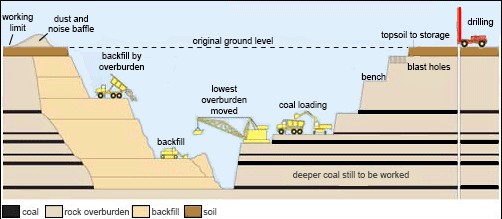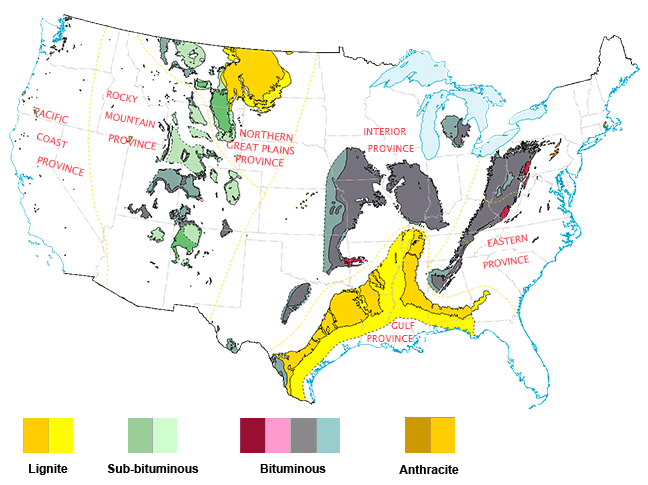Coal: The Rock that Burns


COAL is a solid, combustible, sedimentary, organic rocks. Coal formed when lush vegetation from warm swampy areas died and was buried to later be consolidated between other rock layers and was altered by the combined effects of pressure and heat over millions of years. Carbon is the main component of coal and it also contains varying amounts hydrogen, oxygen, nitrogen, sulphur and other impurities. Many different classifications of coal are used around the world however, the three main types of coal are anthracite, bituminous and lignite
Anthracite coal is the hardest. It averages 85%-95% carbon content and has the highest heating value of the four types of coal. It is not uncommon to find anthracite that produces well in excess of 15,000 Btu's per pound. To put that in perspective, that is roughly one and one-half times as much heat as the same volume of oil and four times as much as seasoned hard-maple firewood. Anthracite makes excellent home heating fuel because it burns cleanly, does not produce volatile gases and does not deteriorate. It can be stored on the ground for long periods of time without creating environmental problems. Anthracite is mined in only a few areas, mostly in the eastern Pennsylvania region. It is used extensively in municipal water purification and treatment plants and for home heating.
Lignite coal is the softest. and is low in carbon but high in hydrogen and oxygen content. It is a brownish black in color, very crumbly and primarily used for the generation of electricity. Because of its color, it is often referred to as brown coal. Lignite is the result of millions of tons of plants and trees that decayed in a swampy atmosphere about 50-70 million years ago. The material on top of the lignite deposits in North Dakota and Montana, called overburden, was deposited by runoff from the west as the Rocky Mountains formed. The heating content of lignite is approximately 4,000-8,000 Btu's per pound. The carbon content of lignite is 25%-35% and it has a very high water content - about 35 percent. For more information about lignite, visit the Lignite Energy Council website.
Bituminous coal is in between. The carbon content of bituminous coal is generally from 45%-85%. Its heat value ranges from 10,500-15,000 Btu's per pound - greater than either lignite or the sub-bituminous types. In addition to being used for electrical generation, it is also used in making coke or coking coal, an essential ingredient in making steel. Most production of bituminous coal is from the east coast to the midwest states and in Alaska.
Peat or peat moss, the precursor to coal, is found in many countries and is also used as an energy source.
A Brief History of Coal Use
Coal has be used for heating since the cave man. Archeologists have also found evidence that the Romans in England used it in the second and third centuries (100-200 AD). Coal from the Fu-shun mine in northeastern China may have been used to smelt copper as early as 3,000 years ago.
In the 1700s, the English found that coal could produce a fuel that burned cleaner and hotter than wood charcoal. In North American during the 1300s, the Hopi Indians in used coal for cooking, heating and to bake the pottery they made from clay. Coal was later rediscovered in the United States by explorers in 1673. However, commercial coal mines did not start operation until the 1740s in Virginia.
The Industrial Revolution played a major role in expanding the use of coal. During the first half of the 1800s, the Industrial Revolution spread to the United States. Steamships and steam-powered railroads were becoming the chief forms of transportation, and they used coal to fuel their boilers.
During the Civil War, weapons factories were beginning to use coal. By 1875, coke (which is made from coal) replaced charcoal as the primary fuel for iron blast furnaces to make steel.
Where is Coal Found
Coal is found in many of the lower 48 states of U.S. and throughout the rest of the world. Coal is mined out of the ground using various methods. Some coal mines are dug by sinking vertical or horizontal shafts deep under ground, and coal miners travel by elevators or trains deep under ground to dig the coal. Other coal is mined in strip mines where huge steam shovels strip away the top layers above the coal. The layers are then restored after the coal is taken away.
Coal is mined in 32 states. The three major U.S. coal producing regions are Appalachia (West Virginia, Pennsylvania, Virginia, Eastern Kentucky, and Ohio), the Illinois Basin (Illinois, Indiana and Western Kentucky) and the Powder River Basin (Wyoming and Montana). Lignite coal is produced primarily in western North Dakota and in eastern Montana.
- Appalachian mines produce primarily bituminous coal from both surface and underground mines. Appalachian coal tends to be high in energy content and low in sulfur.
- Illinois Basin mines also produce primarily bituminous coal but are generally underground operations, yielding coal that is high in energy content but also high in sulfur.
- Powder River Basin coal is of the sub-bituminous type and generally mined from the surface. Basin coal, while often lower in energy content, is known for its particularly low sulfur content.
The way the layers or seams of coal occur and the has much to do with how it is mined and its ultimate cost to consumers. For example, in Illinois Basin mines, 50 feet of overburden must often be removed to reach a 5-10 foot seam of coal. At the other end of the spectrum, in the Powder River Basin, you may only have to remove 5 feet of overburden to get to a 50 foot thick seam - substantially lowering the cost of mining.
Check out our Fossil Fuels Collection and our
Coal Poster to purchase our coal related products.
We also sell individual specimens of coal on our Sedimentary Rocks page.
We also sell individual specimens of coal on our Sedimentary Rocks page.



